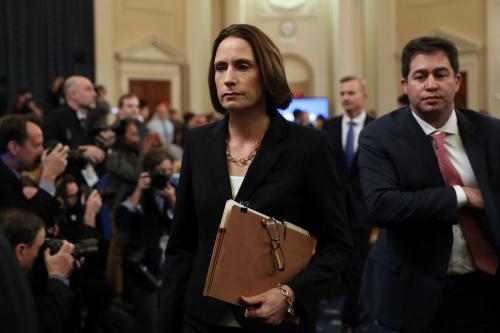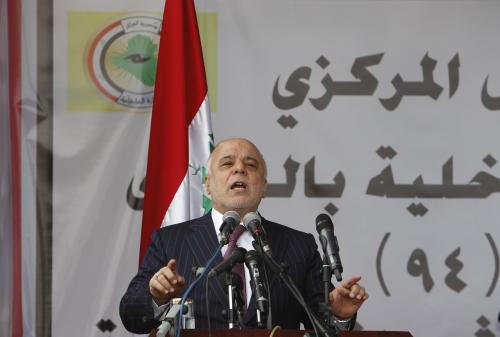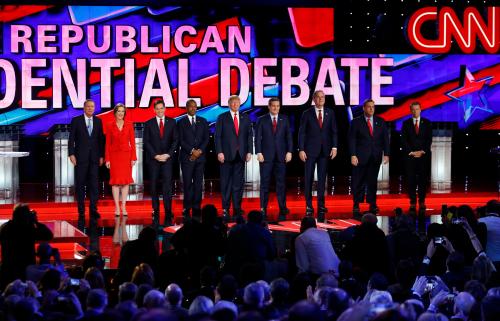When taking the oath of office on January 20 2009, the next president of the United States will be assuming responsibility for the most difficult, dangerous and complex set of foreign policy challenges ever to face a newcomer to the White House. Whatever is then happening in Iraq, Iran, Afghanistan, Pakistan, and the Arab-Israel peace process, it is safe to predict that George W. Bush will, in each case, be passing on to his successor either a daunting piece of unfinished business or a full-blown crisis.
Moreover, in dealing with that morass, the US will need help from a world where its reputation is scraping bottom, from an enfeebled United Nations and from allies whose confidence in America’s stewardship of its own power and their interests has been profoundly shaken. Although Bush has been making an effort to mend fences, and hopes to score some diplomatic points in his final year as president, his bungled occupation of Iraq and his swaggering disregard for international institutions and opinion during his first term still rankle around the world. Many of his fellow leaders are counting the days until he steps down (381 from today).
Whether Republican or Democratic, the administration that replaces Bush’s will have a grace period abroad, just as it will have a honeymoon with Congress. It will need to move quickly and dramatically to demonstrate that respect for international law, treaties and organisations is firmly reinstated as part of the bedrock of American foreign policy.
To send the strongest possible signal to that effect, the next president should, shortly after coming into office, affirm full adherence to the Geneva and UN torture conventions, restore the right of habeas corpus for US-held detainees, and “re-sign” the treaty establishing the International Criminal Court, which the Bush administration “un-signed” in 2002.
Measures such as these would help to repair the US’s ability to muster support for a sustained, multi-front diplomatic offensive – not just in troubled regions, but on global issues where the stakes are even higher.
Therein lies a further predicament awaiting the next president. According to a rueful adage about life in government, the urgent tends to drive out the merely important. For a long time to come, the Middle East will be a cauldron of urgencies. That will make it all the more difficult for any US administration to devote sufficient attention, political capital and diplomatic energy to two mega-threats. One is a new wave of nuclear weapons proliferation; the other is a tipping point in the process of climate change.
The US has a triple responsibility both for these problems and for their solution. It is, after all, the most heavily armed nuclear weapons state; it has been the largest producer of greenhouse gases; and it is the only country that has the capacity to lead the multilateral effort necessary to cope with both challenges. That capacity has been severely diminished during Bush’s presidency.
To make up for lost time, the next administration should undertake an array of initiatives, starting with one directed to Moscow. Drastic reductions in the American and Russian nuclear stockpiles are important as an example to other countries.
The goal of eventually abolishing nuclear weaponry is written into the Nuclear Nonproliferation Treaty (NPT), which the US Senate ratified nearly 40 years ago. Until recently, disarmament has been treated as an object of lip-service. That is beginning to change. A year ago, four prominent statesmen – including the arch-druid of realists, Henry Kissinger – espoused the view (in a Wall Street Journal opinion piece) that realism itself militates in favour of total, universal disarmament as a serious, if long-term, objective. The next US administration may find that it has more political running room than its predecessors to negotiate with Moscow on nuclear weapons levels – and the closer to zero the better.
The US should also resume negotiations with Russia on anti-missile missiles. More than 40 years ago, American statesmen persuaded their Soviet counterparts that the most dangerous – not to mention most expensive – kind of arms race is one in which each side tries to deflect the other’s spears with an elaborate array of shields. In signing the 1972 Anti-Ballistic Missile (ABM) treaty, the Soviet Union reluctantly accepted that logic.
Ronald Reagan, however, did not. Even though he left the ABM treaty intact, he gave political respectability to the scientifically and strategically dubious notion that a space-based super shield could make nuclear-tipped spears “impotent and obsolete”. In 2002, Bush pulled the US out of the ABM treaty. Unless the next administration comes up with new, negotiated means of averting an unregulated offence-defence competition, we are likely to see Russia and China respond by deploying additional intercontinental missiles and taking a variety of measures to overwhelm, penetrate and blind US defences. There could eventually be a similar trend among potential nuclear weapons states.
There is a growing number of countries in that category. The 1990s, the first post-cold war decade, could turn out also to have been a prelude to the post-NPT era, and it will be one of nuclear anarchy.
Today there are nine countries with nuclear weapons: the US, Russia, China, the UK, France, India, Pakistan, North Korea, and, presumptively, Israel. Over the next decade or so, though, a dozen or more other countries might blast their way into the club. The bilateral animosities that might trigger “small” nuclear wars already include India-Pakistan and North Korea-US. In the relatively near future, that list could include Iran-Israel, Israel-Egypt, Iran-Saudi Arabia, China-Taiwan.
At least two US allies are reconsidering long-standing decisions to forego the bomb. The more worried Turkey becomes about its neighbourhood, and the less it feels part of the west and protected by Nato, the more likely it is to seek its own nuclear capacity. In Japan, senior officials of the ruling party, along with members of the foreign-policy elite, have begun suggesting that there should be a national debate about whether their country should acquire nuclear weapons.
The unravelling of the NPT may pose a danger less spectacular than a single, sudden and apocalyptic “exchange” of H-bomb-tipped rockets between the US and the USSR. But the new danger is more plausible than the old one, since it is harder to maintain a stalemate in the deadly game of mutual deterrence when there are multiple small players rather than two big ones.
To make matters worse, the more nations that have nuclear weapons, the greater the risk that some will fall into the hands of sinister non-governmental organisations, or “non-state actors”, such as al-Qaeda. Terrorists with a few primitive nuclear devices are, in their own way, scarier than a superpower with thousands of sophisticated ones. By definition, a suicide bomber is going to be attracted, not deterred, by the prospect of mutual assured destruction. Therefore, the NPT needs to be supplemented by new agreements and enforcement agencies that will keep tight control over lethal technology.
The US should work with all the current nuclear weapons states to impose a moratorium on the production of fissile material, pending a formal, verifiable, universal and permanent ban. To attain that goal, America should join its principal allies and partners in direct, sustained negotiations with Iran and North Korea to bring them back into the NPT as fully compliant non-nuclear weapons states. If those talks are to have any chance of success, Washington will need to establish full diplomatic relations with the governments in Tehran and Pyongyang. In exchange, the world will want North Korea to get rid of its existing weapons and Iran to halt its development programme. Regime change will have to be left to the peoples of those countries.
Another valuable but languishing pact is the Comprehensive Test Ban Treaty (CTBT). The single most short-sighted and harmful act by the US Senate in recent years was its refusal to ratify this treaty in 1999. At that time there were Republican senators who privately acknowledged the recklessness of their party’s action. Perhaps they will be more outspoken and persuasive in 2009, the 10th anniversary of that colossal blunder.
It would help to rescue the CTBT if the next administration, within days of entering office, were to repudiate unambiguously hints from the Bush administration that the US might need to test a new generation of nuclear weapons. That need would be less compelling were there a consensus that the US should lead the way towards the eventual elimination of nuclear weapons. In any event, unless the next president works with the Senate to put the CTBT back on a path towards ratification, it will be impossible for the US to keep other nuclear states from resuming testing – or to keep the nuclear aspirants from testing for the first time.
Hard as preventing a spiral of nuclear proliferation may be, it is easy compared with stabilising climate change. Aside from the technical difficulties, there are heavy financial and political costs associated with the measures necessary to reduce the emission of greenhouse gases. (Arms control and nonproliferation, by contrast, actually save money.) Furthermore, we have been living with the danger of blowing ourselves up for more than 60 years – and we have experience, and success, in not doing so.
By contrast, the danger that we may fatally overheat the earth – or, depending on the vicissitudes of climate change, drown, starve, or, in some parts of the world, freeze ourselves to death – is a new nightmare. The possibility of its coming true lies beyond the horizon of many of us alive today and, perhaps, of our children as well. But our children’s children may well discover whether the optimists or the pessimists were right about climate change, especially since even the optimists are, with nearly every new report, less reassuring.
Dick Cheney famously warned in the context of terrorism that if there is even a one per cent chance of something very bad happening, we should act as though it were a certainty. Since the odds are approaching 100 per cent that if humankind continues to pump greenhouse gases into the atmosphere, it will alter the planet in ways that no one can predict, Cheney’s rule should make him, on the subject of climate change, a soulmate of Al Gore.
As the science of the problem becomes clearer to all of us, the politics, economics, and timetable of the solution become starker: in order to slow down the rate at which the earth is warming, the US, the European Union, Russia, and nine other countries – the so-called “dirty dozen” that account for 80 per cent of the problem – will have to accept drastic and mandatory cuts in emissions. Half of the countries on that list are considered “developing”. Under the Kyoto Protocol, they get a pass on binding reductions. The Big Three are India, China – whose giant populations and thriving economies make them major greenhouse-gas emitters – and Brazil, the leading source of greenhouse gases produced by tropical deforestation. (The other members of the dirty dozen are Canada, South Korea, Mexico, Iran, Australia, and South Africa.)
Kyoto will expire in 2012. That means the next US president will have fewer than four years to play a decisive role in the design of an effective successor to the treaty. The US must do this through diplomacy and by example. Only if it passes legislation imposing stringent limits on itself, while offering other countries – especially developing countries – substanstial incentives to be part of a global effort, will Kyoto be replaced by an accord mandating universal reductions.
It is asking a lot of the world – and the next president of the US – to grapple simultaneously with proliferation and climate change, but it is not asking too much, given the consequences of failure. Greater public awareness of the way in which these and other dangers are connected might help galvanise support of the necessary remedies, sacrifices and trade-offs.
As farmlands turn to dust belts or deserts, and as the sea engulfs heavily populated coastal regions, whole nations will be thrown into economic and political chaos – portending both internal and cross-boarder violence.
Projections indicated that the most onerous effects of climate change will be felt in the poorer parts of the world, where soaring temperatures, encroaching sands, and rising sea levels are likely to cause or hasten the failure of fragile states. In failing, they will teach us about the link between their misery and our insecurity: failed states are often outlaw states, sources of regional instability, incubators of terrorism, and thriving markets for lethal technology.
There is also a connection between climate change and proliferation when it comes to solutions: peaceful nuclear energy is coming back in fashion because it relies on available technology and produces no greenhouse gases. If the world increases its reliance on nuclear-generated electricity, emerging nations will need assistance from advanced industrialised ones to build hundreds of new nuclear power plants. In exchange for that help, they may accept tighter controls on the material and know-how that can be used for bombs. They result could be a 21st-century version of Dwight Eisenhower’s 1953 Atoms for Peace plan – and a much-needed shot in the arm for the languishing NPT.
If history is any guide, it is an open question as to whether humankind is capable of responding adequately to nuclear proliferation and climate change.
By and large, progress in international co-operation has needed spectacular failures in order to yield even modest and temporary progress. It took the thirty years war to bring about the Treaty of Westphalia; the Napoleonic wars motivated the Concert of Europe; the first world war spurred what turned out to be the false start of the League of Nations; only after the second world war did the world’s leaders try again, more successfully, with the United Nations.
The most pertinent and encouraging exception to this woeful pattern was the maintenance of nuclear peace during the cold war: it did not take the actual experience of Armageddon to spur the international regulation of national arsenals: recognition of the menace was sufficient.
At the dawn of the atomic age, Robert Maynard Hutchins, the chancellor of the university of Chicago, saw the detonation of A-bombs over Hiroshima and Nagasaki as heralding “the good news of damnation” – the ultimate wake-up call – that world frighten the leaders of the world into taking the steps necessary to avert catastrophe.
The next US president must act quickly on the hope that the clear and present dangers posed by proliferation and climate change will similarly concentrate minds and political will on what needs to be done – and the recognition that meeting those twin challenges not just as very important but as truly urgent.
Strobe Talbott is president of the Brookings Institution in Washington. His latest book, ‘The Great Experiment: The Story of Ancient Eempires, Modern States, and the Quest for a Global Nation’, is published by Simon & Schuster.



Commentary
Trouble Ahead for the Next U.S. President
January 4, 2008